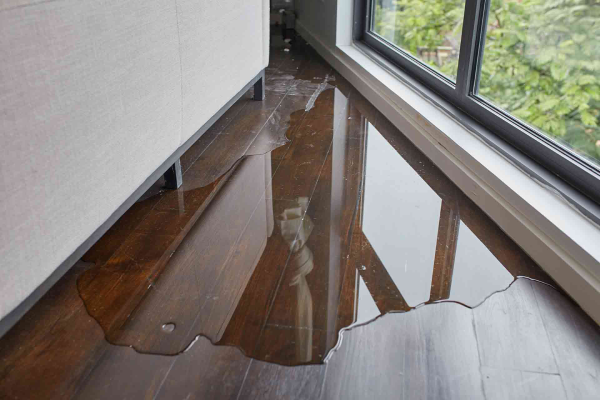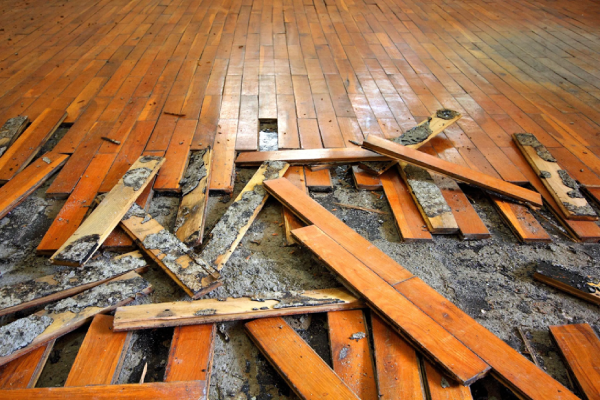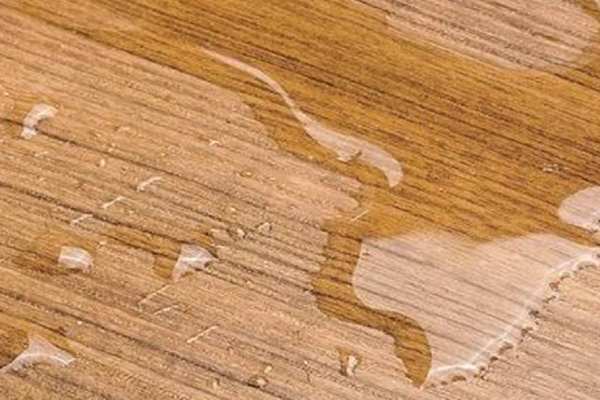Wood flooring adds character, warmth, and time-tested beauty to a space. From classic oak to rich walnut, it instantly elevates the style of a room. But as beautiful as wood floors are, they’re susceptible to one opponent: water. Water damage to wood floors can turn into a homeowner’s nightmare because it bends the boards, stains the surface, and, worst of all, necessitates expensive replacements. In this article, we’ll cover the cause, warning signs, and step-by-step measures for treating hardwood floor water damage. We’ll also illustrate how to choose a reputable water damage restoration service provider in Vancouver.

What Causes Water Damage to Wood Floors?
Wood is a spongy substance. While hardwood floors may be sealed, prolonged exposure to water will inevitably cause them to swell, warp, or rot. Some of the most common reasons for water damage repair to wood floors include:
- Leaking pipes: An out-of-sight pipe leak behind a wall or under a sink can cause ongoing and unperceived damage.
- Pet or spill accidents: Spills are acceptable if you clean them well, but repeated or uncleaned moisture builds up over time.
- Natural disasters: Storm flooding, heavy rain, snowmelt, or storms can affect parts of a floor.
- Appliance failure: Faulty dishwashers, water heaters, and washing machines are well-known for water damage to wood floors.
- Crawl space humidity or basement moisture: Even moisture that migrates up from under the floor can harm it over time.
- Leaking roofs: Leaking water from the ceiling can move to the floors and go unnoticed.
Even indoor humidity, especially in kitchens, bathrooms, or basements, can quietly influence wood floors for months or years. Prevention, early detection, and hardwood floor repair water damage are very important.
Signs of Water Damage on Wood Floors
All of the water damage to wood floors is not visible, and it starts and increases with time. Here are some of the most typical signs that show the need for hardwood floor repair water damage:
- Discoloration or staining: There may be dark stains or milky patches where water has soaked.
- Cupping: Where the edges of the wood planks sag upwards, with a wavy effect.
- Crowning: Inverse cupping, where the center of the board extends upward.
- Buckling: The floor rises completely off the subfloor. This is among the most severe effects of water damage to wood floors.
- Musty odor: The lasting damp smell shows mold or mildew growing beneath the surface.
- Squeaky or spongy spots: When stepping across an affected area that is made of wood, the boards will feel soft, empty, or creak.
Even if only a small part of your floor indicates being wet, it’s important to check. Water tends to flow underneath the surface.
How to Handle Water Damage to Wood Floors
Time is very important when the floor gets wet, and it can prevent future expenses to repair flood damage. Do these activities as soon as you see the signs of wetness to do wood floor water damage repair:
1. Shut off the source of water
If it’s a burst pipe or a flooded sink, shut off the water supply immediately. Turn off the valves and get a plumber if you have no idea what is the cause of it.
2. Absorb standing water
Soak up as much water as possible with towels, a wet/dry vacuum, or mops. The longer the water is there, the deeper it seeps.
3. Dry the room carefully
Open windows, run fans, and install dehumidifiers. Place them near the affected area to draw out moisture from the wood. You can even use a hairdryer on low heat for tiny spots.
4. Move furniture
Displace rugs, furniture, and anything that is resting on the floor to prevent staining and create airflow.
When you resolve the immediate issue, check more specifics to see whether or not you can repair water-damaged wood or if replacement is necessary.
Repairing Water Damaged Wood Floors
When the hardwood floor water damage is minor, such as cupping or staining, repair is possible. With more severe or widespread damage, you should do different work. Below is a general guide:
Step 1: Let the Floor Dry Completely
This may take a few days, even with ventilation. Moisture meters assist in determining when the wood is actually dry inside, not just on the surface.
Step 2: Sanding the Floor
After drying, sanding can eliminate cupping, crowning, and discoloration. But this will only be effective if the damage is superficial and the boards haven’t warped excessively.
Step 3: Refinishing
Once sanded, you should add a new stain and protective coating to bring back the appearance of your floor. This is also a good opportunity to update the overall look.
Step 4: Replacing Severely Damaged Boards
When there are buckled or rotten boards, you should remove and replace them. A professional will try to match new planks to your flooring as closely as possible.
Step 5: Check the Subfloor
At times, the damage extends past the hardwood into the plywood subfloor. If so, repairs will take longer and cost more, but not doing this step to repair water damage to wood floors can create future problems.
You should seek professional assistance if more than 30% of the floor is damaged or if mold exists.
Avoid These Common Mistakes to Repair Water Damage to Wood Floors
With hardwood floor water damage, many people unintentionally make matters worse. Here are common mistakes:
- Delay: Waiting too long allows water to penetrate deeper and encourages mold.
- Blasts of heat: Don’t blast the area with hot blasts of air; it may cause boards to split.
- Smell notice: A musty smell means that there is water trapped somewhere. It won’t go away on its own.
- Omission of subfloor examination: The top wood may be fine, but there is damage underneath.
- Amateur replacement without experience: Incorrect installation may lead to warped boards and new damage.
Vancouver Water Damage Restoration Services
It is a real risk to live in a seaside or rainy environment such as Vancouver. Here are restoration services in:
· North Vancouver
North Vancouver is especially prone to basement flooding and roof leaks, so reliable water damage restoration North Vancouver service are essential. Restoration experts here act fast to prevent mold growth and structural issues, offering emergency response and full moisture remediation to restore your home quickly and safely.
· West Vancouver
Residents rely on water damage restoration West Vancouver professionals protect high-end materials like hardwood and marble, ensuring a rapid and discreet recovery process. They arrive fully equipped to extract and dry all water efficiently.
Avoiding Future Water Damage
The ideal repair for water damage to wood floors is the one you never have to make. The following are preventive methods to safeguard your investment:
- Install waterproof mats around sinks, dishwashers, and doorways.
- Seal your hardwood floors every few years to keep the surface water-resistant.
- Check plumbing regularly, especially under sinks and around appliances.
- Use moisture sensors that alert you to hidden leaks before they become an issue.
- Control indoor humidity, especially in kitchens, bathrooms, and basements.
These simple steps will mean that you never have to repair water damaged wood again.
Conclusion
Dealing with wood floor water damage repair can be frustrating, but it’s not the end of the world. Timely discovery, rapid response, and correct restoration techniques can often save your floor and your wallet from paying high costs. No matter whether it’s a small spill or a huge leak, having an idea of what to see and how to react can be the difference between success and disaster. And if you’re in Vancouver, North Vancouver, or West Vancouver, help is just around the corner.
Expert Water Damage Recovery with Revive Restoration
Revive Restoration is a professional water damage restoration company dedicated to helping homeowners and businesses recover from floods, leaks, and moisture-related issues. With a team of experienced technicians and state-of-the-art equipment, we offer fast and reliable services, including water extraction, drying, mold prevention, and floor repair. With the proper equipment and knowledge, we dry your floor and repair it everywhere better and stronger than ever. Call Revive Restoration today for a free consultation.




